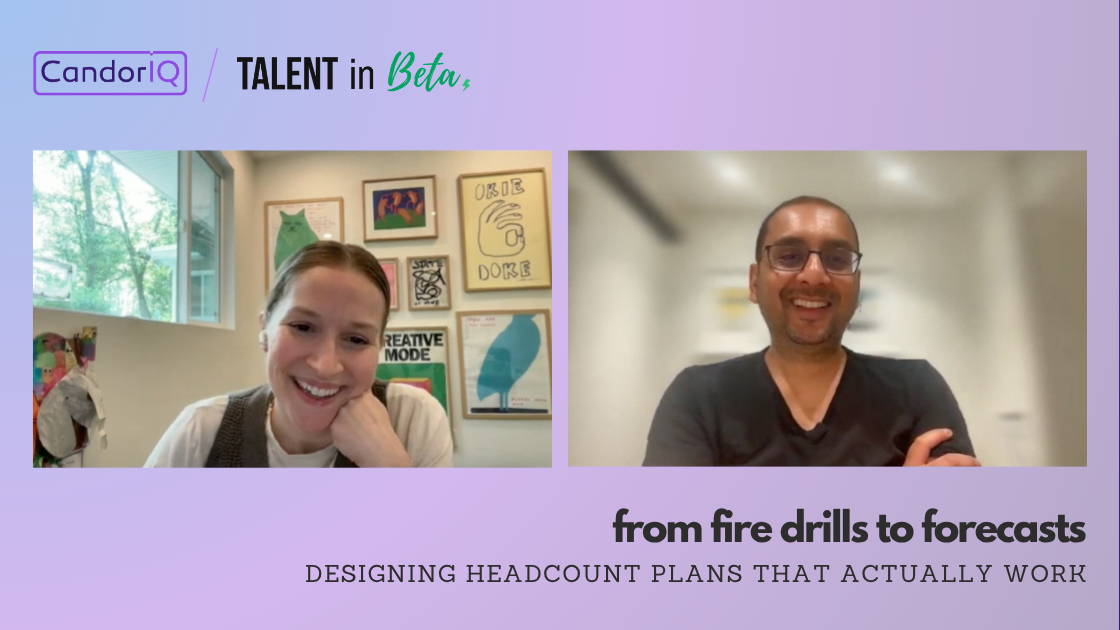Recap: From Fire Drills to Forecasts, Webinar with Talent Leader Katie Wagner and Haris Ikram
How Katie Wagner and Haris Ikram unpacked why headcount forecasts fail, the risks of reactive hiring, and practical strategies for building flexible, cross-functional workforce and headcount planning.

Headcount planning is one of the most important—and most fragile—parts of scaling a business. Too often, forecasts collapse under the weight of reality, leaving Talent teams scrambling, Finance frustrated, and business goals at risk.
In a recent webinar, Katie Wagner (Principal, Advisory at Growth by Design Talent; Talent in Beta) and Haris Ikram (Co-Founder & CEO of CandorIQ) dug into why headcount plans break, what it means for founders and leadership, and how to design a better system.
The Vicious Cycle of Recruiting
Katie opened with a familiar pain point: recruiting often feels like it’s constantly behind.
“It’s this vicious cycle of recruiting feeling like it’s always reactive… Talent leaders spend a ton of time just moving people around. I always call it a puzzle of recruiter capacity.”
The root cause isn’t “slow recruiters.” It’s broken forecasts. Finance locks the plan based on what’s known at the time, but when reality shifts—whether it’s a big new customer, a new product feature, or a sales incentive plan—headcount needs spike. Recruiting, which built capacity against the original plan, suddenly looks late to the party.
As Haris noted: “When capacity planning is lagging, it has real impact on the workforce.”
Why Founders Should Care
This isn’t just an HR problem—it’s a business problem. Katie outlined the risks of reactionary hiring:
- Missed business goals when critical roles can’t be filled fast enough.
- Settling for speed over quality, which can lead to mis-hires.
- Overspending to close candidates urgently.
- Customer churn if the company can’t deliver on promises or support growth.
“If you’re lagging behind on recruiting… there’s a risk of missed business goals,” Katie explained. “And if you’re reacting and hiring urgently, there’s risk with hiring the wrong talent or overspending just to close.”
Haris added that the downstream impact is often underestimated: one missing hire can create a “daisy chain effect” across departments—delaying product launches, slowing sales, or stalling customer success.
Building a Better Loop
So how do you prevent fire drills from becoming the norm? Katie shared a framework:
- Start with the company plan (AOP).
- Layer in recruiting scenarios. What can Talent realistically deliver with current resources?
- Co-build with Finance. Headcount planning should be a partnership, not a handoff.
- Treat plans as living systems. Keep iterating as business needs evolve.
“In a perfect world, Talent is in the room during the planning period,” Katie said. “And then you set regular follow-ups—weekly or monthly—depending on how fast things change.”
This feedback loop allows Talent leaders to point out issues in real time. For example: “You’re creating a new incentive plan—does that mean higher sales targets? How will that impact hiring?”

Tactical Practices That Work
Katie and Haris discussed practical tactics for staying ahead of shifting needs:
- Weekly Business Reviews (WBRs): Create cross-functional forums where each department shares goals, progress, and new initiatives—and flag the headcount implications.
- Breakout sessions for tradeoffs: If multiple teams need the same resources, smaller groups can problem-solve headcount priorities.
- Clear communication cadence: Align expectations across Finance, Talent, and business leaders.
- Tooling: Move beyond spreadsheets toward systems that connect Finance, HR, Talent, and (eventually) Product and Growth.
- Ask the right questions: Sometimes the solution isn’t more headcount—it might be process, tooling, or AI.
Katie noted, “I’ve seen a lot of systems, and the one that always works the best is the one that helps cross-functional teams speak the same language. At a minimum, put a recurring meeting on the books.”
The Role of AI
The conversation turned to the future state of workforce planning. Katie’s “blue sky” vision is AI-assisted scenario planning:
“Any leader could come into a tool, input a new initiative, and it would spit out a full headcount plan, org design, costs, and recruiting strategy—localized to the company’s real data. That would save Talent leaders countless hours.”
Haris pointed out that companies like CandorIQ are beginning to integrate these capabilities—tying revenue, compensation, and workforce data together so scenarios can be modeled quickly and clearly.
Key Takeaways
Katie closed with three takeaways for leaders:
- Cross-functional collaboration is non-negotiable. Get Talent, Finance, and business leaders in the room.
- Have a clear agenda. Meetings should flag initiatives, tradeoffs, and headcount implications.
- Stay flexible. Plans should shift as the business grows and succeeds.
Haris summed it up: “Business is living and breathing. So your forecast has to be living and breathing too.”
Want more from Katie? Subscribe to her Substack Talent in Beta for practical insights on building scalable hiring systems.
Want to see what CandorIQ is building? Explore CandorIQ’s platform for workforce and headcount planning.
Watch the full webinar here.


